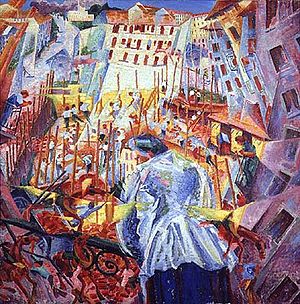The Street Enters the House
| The Street Enters The House | |
|---|---|
| Italian: La Strada Entra Nella Casa | |
 |
|
| Artist | Umberto Boccioni |
| Year | 1912 |
| Medium | Oil on canvas |
| Dimensions | 100.0 cm × 100.5 cm (39.4 in × 39.6 in) |
| Location | Sprengel Museum, Hanover, Germany |
The Street Enters the House (La Strada Entra Nella Casa) is an oil on canvas painting by Italian artist Umberto Boccioni. Painted in the Futurist style, the work centres on a woman on a balcony in front of a busy street, with the sounds of the activity below portrayed as a riot of shapes and colours.
The first public display of the painting was in Paris, in 1912, as part of the first Futurist exhibition. It is now housed in the Sprengel Museum in Hanover, Germany.
Boccioni was one of the founding members of the Futurist movement. Until 1910, the group concentrated primarily on capturing "emotion and multiple states of mind" using techniques derived from Neoimpressionism style (for example, Severini's The Black Cat or The Obsessive Dancer). After hearing second-hand reports of the innovations of Picasso and Braque, Boccioni and his compatriots adapted their technique to match, incorporating angular lines and intersecting planes as a way of capturing multiple viewpoints in a two-dimensional image. While this was going on, there was a corresponding shift in what the group was attempting to capture as well. They began to focus more heavily on the physical and the external rather than the emotional and internal.
In 1910, Boccioni began a series of works based on modern urbanism. The first, The City Rises, described the construction of a new city and the sights and sounds of men and horses at work. He described it as a "great synthesis of labour, light, and movement." His later works, such as The Forces of the Street, The Street Enters the House, Simultaneity of Vision, and Street-pavers and A Study of a Woman Among Buildings were elaborations on the same theme.
The central figure of The Street Enters the House is a woman dressed in blue and white, viewed from behind and above. She looks over her balcony at a busy street scene, a riot of colours, lines, and angles. On the road in front of her, workers lift poles to form the walls of a new building, surrounded by a pile of bricks. On every side of this construction, white and blue houses lean into the street. Two of the balconies are occupied by other figures peering down into the road. A line of horses flies past the foreground.
...
Wikipedia
